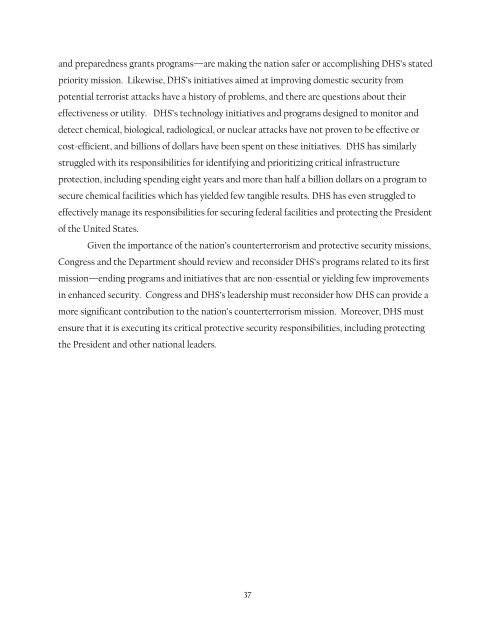010815as1
Create successful ePaper yourself
Turn your PDF publications into a flip-book with our unique Google optimized e-Paper software.
and preparedness grants programs—are making the nation safer or accomplishing DHS’s stated<br />
priority mission. Likewise, DHS’s initiatives aimed at improving domestic security from<br />
potential terrorist attacks have a history of problems, and there are questions about their<br />
effectiveness or utility. DHS’s technology initiatives and programs designed to monitor and<br />
detect chemical, biological, radiological, or nuclear attacks have not proven to be effective or<br />
cost-efficient, and billions of dollars have been spent on these initiatives. DHS has similarly<br />
struggled with its responsibilities for identifying and prioritizing critical infrastructure<br />
protection, including spending eight years and more than half a billion dollars on a program to<br />
secure chemical facilities which has yielded few tangible results. DHS has even struggled to<br />
effectively manage its responsibilities for securing federal facilities and protecting the President<br />
of the United States.<br />
Given the importance of the nation’s counterterrorism and protective security missions,<br />
Congress and the Department should review and reconsider DHS’s programs related to its first<br />
mission—ending programs and initiatives that are non-essential or yielding few improvements<br />
in enhanced security. Congress and DHS’s leadership must reconsider how DHS can provide a<br />
more significant contribution to the nation’s counterterrorism mission. Moreover, DHS must<br />
ensure that it is executing its critical protective security responsibilities, including protecting<br />
the President and other national leaders.<br />
37








![55721335-d6fe09eb5ffdcc87dbf6c3f0b5bbda07d2261e98[1]](https://img.yumpu.com/56533583/1/186x260/55721335-d6fe09eb5ffdcc87dbf6c3f0b5bbda07d2261e981.jpg?quality=85)








